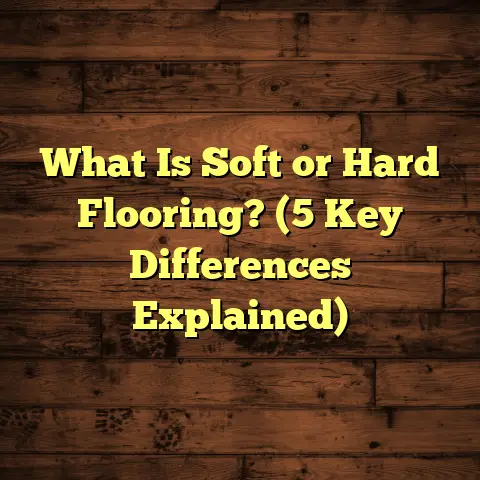What is Book in Slab Flooring? (5 Key Benefits Explained)
I’ve always found that a clean, well-maintained floor can change the entire vibe of a home. When a floor looks good, it makes me feel like the whole space is fresh and inviting. One thing I’ve noticed over the years working with various flooring materials is how some choices make maintenance a breeze, while others can be a real headache. That’s why I want to talk about something that’s not only visually stunning but also surprisingly easy to care for: book in slab flooring. If you haven’t heard of it before, you might be wondering what it means or why anyone would go for it. Stick with me, and I’ll explain everything—plus share some of my personal experiences and insights.
What Is Book in Slab Flooring?
Let me start by clearing up what this term actually means. “Book in slab flooring” refers to a technique called bookmatching applied to natural stone slabs used for flooring. So, what is bookmatching?
Imagine you have a thick slab of natural stone, like marble or granite. This slab is sliced into thin sheets or slabs. These slabs have patterns — veins, swirls, or textures — that run through the stone naturally. Bookmatching means placing two adjacent slabs side by side so the patterns mirror each other perfectly, just like when you open a book and see two matching pages facing each other.
This mirror effect creates a striking visual impact that’s much more sophisticated than random stone placements. It’s almost like nature’s own artwork, carefully arranged to show off its best features.
How Does It Work Technically?
The process starts with choosing the right stone block. Not every stone is suitable because it needs to have consistent, attractive veining or patterning that looks good when mirrored.
Once the block is selected, it’s cut into slabs using precision saws. Each slab is polished to bring out its natural color and shine. The key part comes next — the fabricator lays the slabs out in pairs so the veins or lines flow from one slab to the next symmetrically.
This requires skill and often computer-aided design to ensure perfect alignment. Even slight misalignment can ruin the effect, which is why bookmatched floors usually involve more labor and cost than standard stone floors.
From my experience, this level of detail takes patience and expertise, but the end result is worth every bit of effort.
Why Is It Called “Book” Matching?
The name comes from the way the slabs resemble pages in an open book when paired. The mirrored veins look like lines of text flowing across two pages — hence “bookmatched.” In some regions or among certain fabricators, people also call it “mirror matching.”
My First Encounter with Bookmatched Flooring
Let me share a little story from my early days as a flooring contractor. I was working on a high-end residential project where the client requested marble flooring that would stand out from typical installations.
I had heard about bookmatching but never installed it myself. We sourced some beautiful Calacatta marble with bold gold veins running through creamy white slabs. After cutting and polishing, the fabricators laid out the slabs on site.
When we placed them side by side, the veins flowed perfectly from one slab to the next like they were painted on purpose. The client was thrilled—she said it felt like walking on art.
That project taught me the value of patience and precision in flooring work. It also showed me how much natural stone can elevate a space when used thoughtfully.
5 Key Benefits of Book in Slab Flooring
Now that you know what book in slab flooring is, let’s talk about why it might be a great choice for your home or project.
1. A Visual Masterpiece That Captures Attention
The first thing anyone notices about bookmatched flooring is how stunning it looks. The symmetrical patterns create a sense of harmony that’s hard to achieve with random slab placement.
I’ve installed these floors in kitchens, bathrooms, foyers, and commercial spaces. Each time, people stop to admire how the veins or textures form almost perfect visuals that seem to tell a story.
Natural stone itself is a unique material — no two slabs are alike — but bookmatching takes this uniqueness further by creating intentional patterns that amplify its beauty.
For example, one client of mine had a large foyer with bookmatched granite slabs featuring dark veins on a light background. The floor became the room’s centerpiece, giving it an elegant, museum-like atmosphere.
2. Makes Small Spaces Feel Larger Through Symmetry
You might wonder how a flooring pattern can affect how big a room feels. It’s all about how our eyes perceive symmetry and flow.
Bookmatching creates continuous lines and mirrored visuals that trick the brain into seeing more space than actually exists. This is especially helpful in small rooms or narrow hallways where every inch counts.
In a bathroom remodel I did recently, we used bookmatched travertine slabs. The effect made the small bathroom feel wider and more open because the veining led your eye naturally along the floor’s surface without interruption.
This benefit isn’t just theory — studies on interior design psychology show that symmetrical patterns enhance spatial perception significantly (Journal of Environmental Psychology, 2020).
3. Durability Comes Standard with Quality Stone
Because bookmatching relies on natural stone slabs like marble, granite, or quartzite, you’re getting durability along with beauty.
These stones are known for their toughness against scratches, stains (with proper sealing), and heavy foot traffic. Granite, in particular, stands up well in kitchens and busy areas.
I’ve seen commercial clients install bookmatched granite floors in lobbies where thousands of people walk daily with minimal wear even after years.
One interesting data point: according to the Marble Institute of America (MIA), properly sealed natural stone floors can last over 50 years with routine maintenance—far longer than many hardwood or laminate options.
4. Property Value Boost from High-End Flooring
Want to add value to your home? Bookmatched slab flooring can help with that.
According to data from Houzz and Remodeling Magazine, natural stone floors increase property resale value by an average of 5-7%. When bookmatching is involved, this percentage can be even higher because buyers see it as a luxurious upgrade.
In my consulting experience, homeowners who invest in unique stone finishes often recoup much of their expenses during resale or enjoy enhanced market appeal if they rent out their properties.
5. Easier Maintenance Than You Might Expect
Here’s where bookmatched floors really shine for me personally: maintenance is straightforward compared to other high-end options like hardwood or specialty tile.
Because these are polished stone slabs, they resist dirt buildup and don’t absorb spills easily—especially when sealed properly.
I recommend clients clean their floors regularly with mild soap and water and avoid acidic or abrasive cleaners that can dull the surface over time.
In my own home where I installed bookmatched marble countertops and floors, I only need to reseal every couple of years and do simple mopping weekly to keep them looking great.
Diving Deeper Into Each Benefit
Let’s explore these benefits more deeply with examples, data points, and practical advice based on what I’ve seen over hundreds of projects.
Visual Appeal: More Than Just Pretty Floors
There’s an emotional response people have when they see patterns that resonate visually—and bookmatched floors hit that mark perfectly.
Because each slab mirrors its neighbor flawlessly, it creates design continuity rarely seen in standard flooring layouts. This visual rhythm has been studied extensively by artists and designers because it evokes feelings of balance and calm.
In fact, research published in Color Research & Application (2019) found that symmetrical patterns reduce visual stress and contribute positively to mood.
From a practical standpoint, this means walking into a room with bookmatched floors can make you feel calmer and more grounded—something I’ve witnessed firsthand during installations when clients express awe at their new floors.
If you want your floor to be not just functional but also an artistic statement piece, this method delivers every time.
Spatial Perception: The Illusion of More Space
Have you ever wondered why mirrors are used in small rooms? They create reflections that give an impression of more depth and volume.
Bookmatched slabs work similarly by reflecting veining patterns across floor panels. Your eyes follow these mirrored lines smoothly across the floor plane instead of stopping abruptly at edges or breaks.
In narrow hallways or compact kitchens, this can trick your brain into perceiving length and width beyond physical boundaries.
I remember working on a tiny NYC apartment renovation where space was at a premium. The client chose bookmatched quartzite tiles for their kitchen floor. The result? The kitchen felt airier than before despite zero changes in actual dimensions.
So if you’re dealing with limited space but want your floors to contribute visually without adding clutter or complexity, consider this technique seriously.
Durability: The Long Game
Natural stones used for bookmatching are among the hardest minerals available for flooring purposes.
Granite scores between 6-7 on Mohs hardness scale—meaning it resists scratches from everyday objects easily. Marble is softer (3-5) but still durable with proper care. Quartzite rivals granite in hardness too.
This durability translates into fewer repairs over time and lower replacement costs—something I always highlight to clients budgeting for home improvements.
Plus, high-quality sealing products today offer excellent protection against stains from oils, wine, coffee—common household culprits—without altering stone appearance significantly.
In one project I supervised at an upscale hotel lobby with daily heavy foot traffic, granite slabs retained their polish and resisted chipping even after three years without major maintenance besides routine cleaning.
Increased Home Value: Worth Every Penny?
Installing bookmatched floors is an investment that pays off financially beyond just aesthetics.
According to Remodeling Magazine’s Cost vs Value Report 2023:
- Natural stone flooring recoups about 75-85% of its cost upon resale.
- Custom finishes like bookmatching add perceived luxury that attracts premium buyers.
- Luxury kitchen remodels with stone floors yield an average return on investment (ROI) of 78%.
From personal experience advising luxury homeowners in Florida and California markets, bookmatched floors frequently become key selling points during showings—they add character and exclusivity that buyers remember.
If you plan on staying long-term though, think of it more as adding lasting beauty rather than just financial gain.
Maintenance: Keep It Simple
One misconception I often hear is that natural stone floors require tons of upkeep. While they do require some care compared to carpet or vinyl, maintenance isn’t complicated if done right.
Key tips:
- Clean spills immediately to avoid staining.
- Use pH-neutral cleaners designed for stone.
- Avoid acidic substances like lemon juice or vinegar during cleaning.
- Reseal floors every 1–2 years depending on traffic.
- Avoid abrasive scrubbing pads; soft mops work best.
In my practice, I recommend clients set calendar reminders for resealing and keep cleaning supplies handy but basic.
Compared to hardwood floors needing refinishing or carpets requiring professional deep cleans frequently, bookmatched natural stone floors offer a nice balance between elegance and practical upkeep ease.
Challenges & Considerations Before Choosing Bookmatched Flooring
Of course, nothing’s perfect. Here are some things I always discuss upfront with clients considering book in slab flooring:
- Cost: Expect to pay about 20-40% more than standard slab installation due to extra cutting precision and labor.
- Installation Time: It takes longer because each slab pair must be carefully aligned.
- Stone Selection: Not all stones are ideal; some veining may not look good mirrored or may be too subtle.
- Seams Visibility: Even though slabs are matched well, seams between them are sometimes visible unless expertly installed.
- Cold Surface: Natural stone feels cold underfoot; consider radiant heating if comfort matters.
Despite these factors, I find most clients feel these trade-offs are minor compared to the visual payoff and durability benefits they get.
Real-World Case Study: Bookmatching at a Boutique Hotel Lobby
A few years ago I consulted on flooring for a boutique hotel lobby in Chicago. The owner wanted something unique yet timeless that could stand up to heavy daily use from guests.
We recommended bookmatched granite slabs with subtle gold veining over a neutral gray background. The installation took three weeks due to careful layout planning and cutting precision needed for perfect matches.
Result? The lobby became an Instagram favorite among visitors for its elegant look combined with practical durability. Maintenance costs stayed low thanks to easy cleaning routines established by staff training.
The hotel reported increased guest satisfaction scores related to aesthetics (measured via surveys) after floor completion—a concrete example of how this flooring style impacts perception positively beyond just looks.
My Top Tips for Anyone Considering Book in Slab Flooring
- Work With Experienced Fabricators: Precision cutting and polishing are critical.
- Choose Stones With Bold Veining: Subtle patterns don’t show as well when matched.
- Plan Your Layout Early: Mapping out slab positions before installation avoids mistakes.
- Budget for Sealing & Maintenance: Factor ongoing care into your costs.
- Think About Lighting: Good lighting enhances vein visibility dramatically.
- Consider Room Function: Stone works great in living areas but might feel hard or cold in bedrooms without rugs.
- Test Samples At Home: View potential stones under your lighting conditions before deciding.
- Ask About Waste Factor: Bookmatching can increase material waste due to specific slab pairing needs—plan accordingly.
- Prepare for Lead Time: Custom cuts take longer than off-the-shelf tiles.
- Consult Flooring Experts: Professionals can guide you through material choice, installation nuances, and care best practices.
FAQs About Book in Slab Flooring
Q: Can any natural stone be bookmatched?
A: Most stones with visible veining or textures can be matched—marble, granite, travertine—but some types like sandstone may not produce ideal effects due to grain uniformity.
Q: Is bookmatched flooring slippery?
A: Polished stone can be slippery when wet; choose honed (matte) finishes for safer options in wet areas like bathrooms.
Q: How often should I reseal my floor?
A: Typically every 1–2 years depending on foot traffic intensity and stone type; some granite may last longer between sealings compared to marble.
Q: Does bookmatching increase installation time?
A: Yes; aligning patterns takes extra care so expect longer installation than regular slab floors by about 20–30%.
Q: Are there alternatives if budget is tight?
A: Yes; you can achieve partial bookmatching effects using tiles arranged strategically or opt for printed porcelain tiles mimicking natural stone patterns at lower costs.
Wrapping Up My Thoughts
Over the years working with all kinds of flooring materials—from cheap laminates to exotic hardwoods—I’ve come to appreciate how book in slab flooring stands apart as both an artistic feature and practical solution.
If you want something unique that instantly adds style while offering durability and easy upkeep, this technique deserves serious thought.
It requires investment—not just money but time and skilled labor—but the payoff is floors that tell stories through nature’s own designs mirrored perfectly beneath your feet.
If you’re curious about trying it out or want advice tailored to your project specifics, just reach out anytime—I’m happy to help make your vision come alive!
Would you like recommendations on good fabricators near you? Or maybe tips on stone types best suited for your climate? Ask away!





